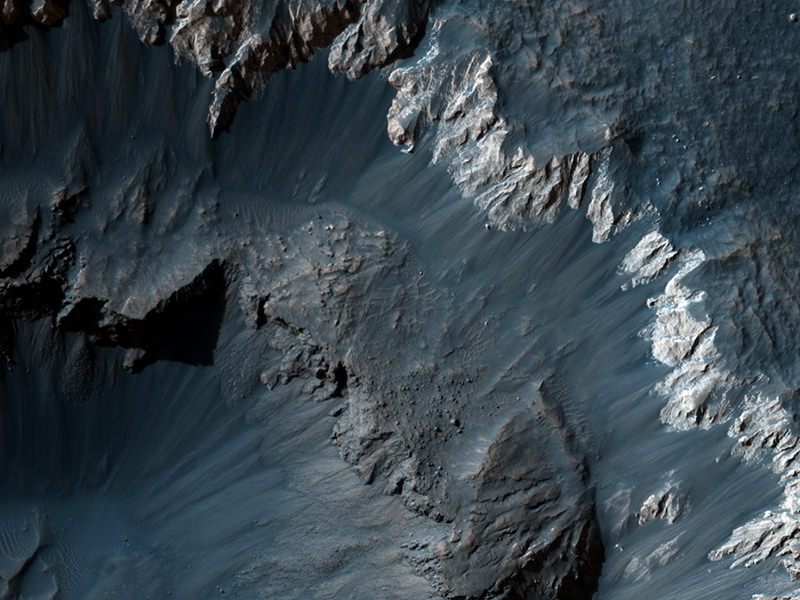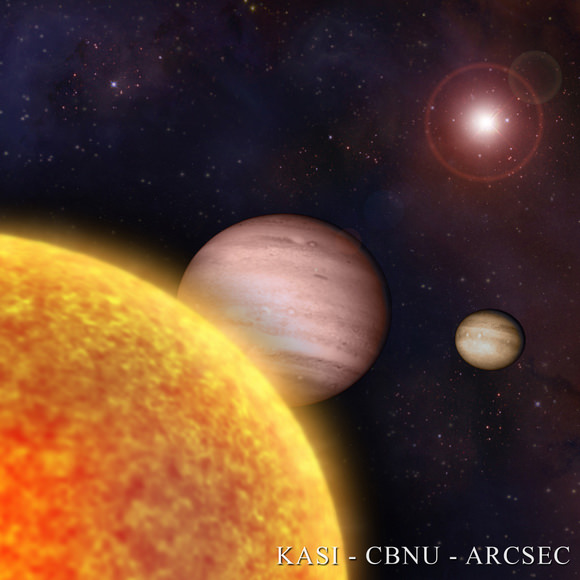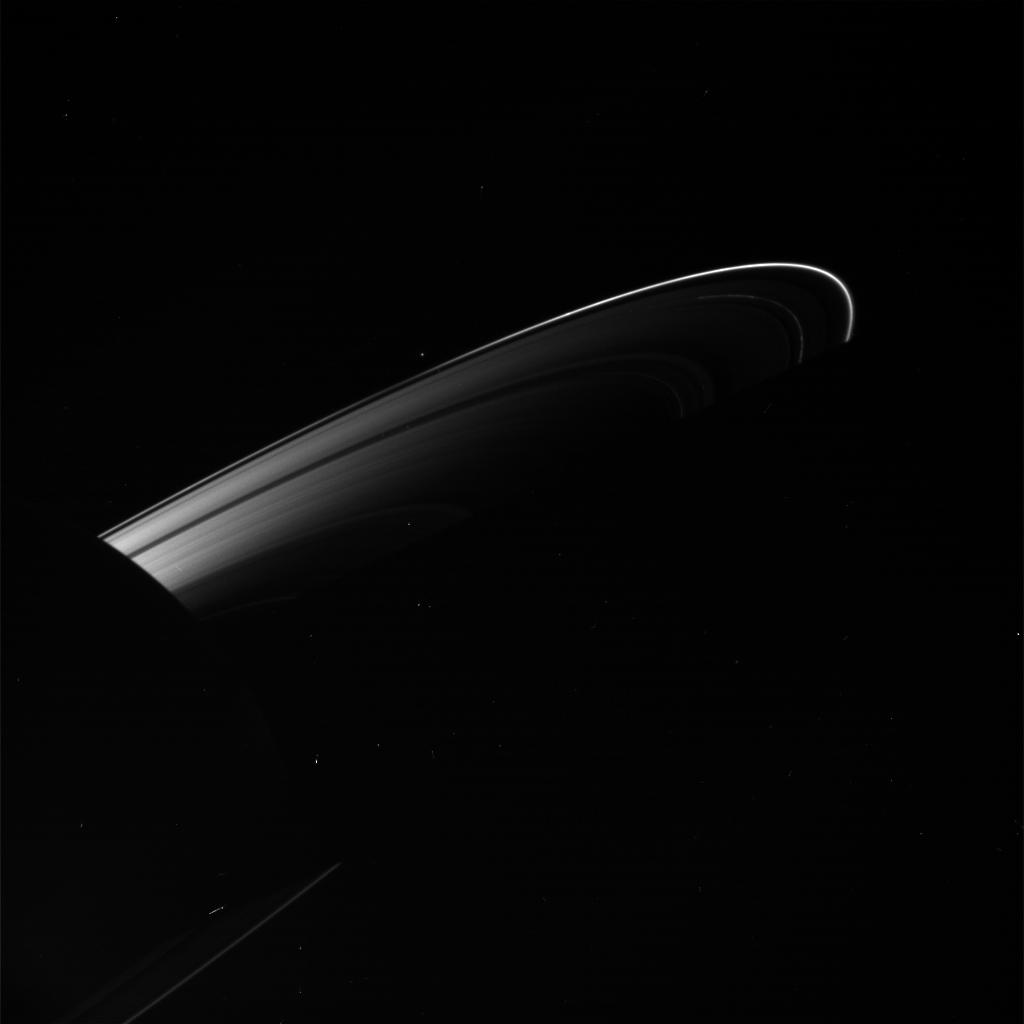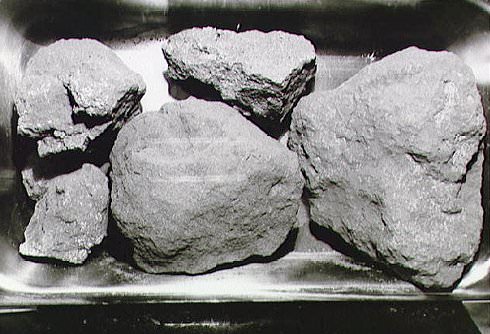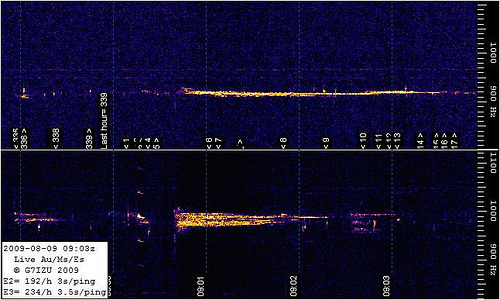[/caption]
I was just thinking it had been awhile since we featured images from the HiRISE camera onboard the Mars Reconnaissance Orbiter spacecraft, so I moseyed over to the HiRISE website only to be blown away by their newest releases. This incredible crater in Meridiani Planum shows a possible double whammy of impacts. It looks as though material filled in the original crater only to be blown out a second time. Another option is that the material in the crater could have collapsed, giving the appearance of a second impact. You can bet the HiRISE team will be looking more closely at this one. Before we move on to more great images, an update on MRO, which unexpectedly went into “safe” mode last week: MRO has now been restored to full operations, after switching to its backup computer. Engineers successfully transitioned the orbiter out of limited-activity “safe” mode on Saturday, Aug. 8, and resumed use of the spacecraft’s science instruments on Monday, Aug. 10. This has happened a few times, and engineers are trying to figure out the root cause of this.
Now, on to the images!
Continue reading “HiRISE Highlights: Crater Within a Crater, Awesome View of Victoria and More”
Trigger-Happy Star Formation in Cepheus B
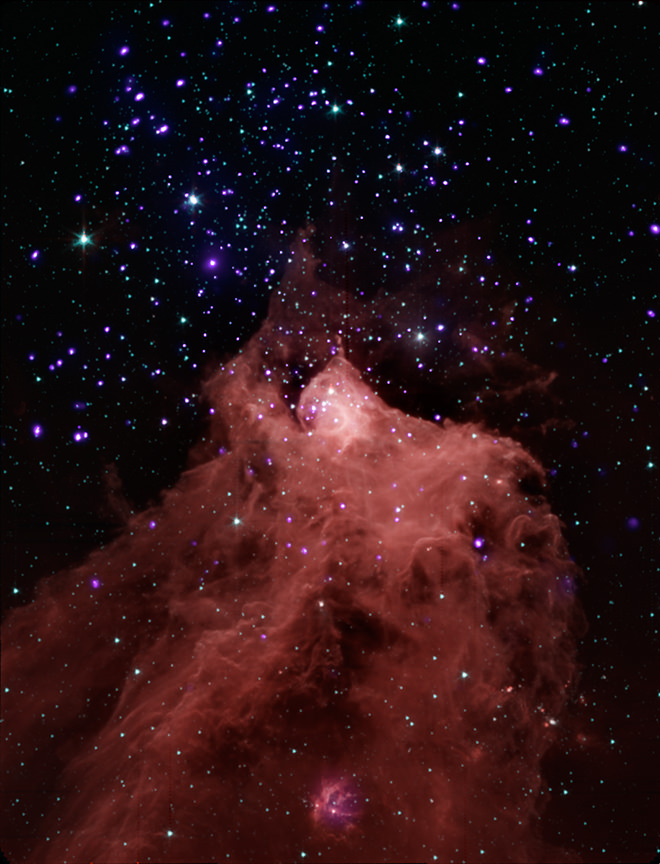
[/caption]
Combining data from the Chandra X-Ray Observatory and the Spitizer Space Telescope allowed astronomers to create this gorgeous new image of Cepheus B. Besides being incredible eye candy, the new image also provides fresh insight into how some stars are born. The research shows that radiation from massive stars may trigger the formation of many more stars than previously thought.
While astronomers have long understood that stars and planets form from the collapse of a cloud of gas, the question of the main causes of this process has remained open.
“Astronomers have generally believed that it’s somewhat rare for stars and planets to be triggered into formation by radiation from massive stars,” said Konstantin Getman of Penn State University, and lead author of the study. “Our new result shows this belief is likely to be wrong.”

The new study suggests that star formation in the region of study in this image, Cepheus B, is mainly triggered by radiation from one bright, massive star outside the molecular cloud. According to theoretical models, radiation from this star would drive a compression wave into the cloud triggering star formation in the interior, while evaporating the cloud’s outer layers. The Chandra-Spitzer analysis revealed slightly older stars outside the cloud while the youngest stars with the most protoplanetary disks congregate in the cloud interior — exactly what is predicted from the triggered star formation scenario.
“We essentially see a wave of star and planet formation that is rippling through this cloud,” said co-author Eric Feigelson, also of Penn State. “Outside the cloud, the stars probably have newly born planets while inside the cloud the planets are still gestating.”
Cepheus B is a cloud of mainly cool molecular hydrogen located about 2,400 light years from the Earth. There are hundreds of very young stars inside and around the cloud — ranging from a few millions years old outside the cloud to less than a million in the interior — making it an important testing ground for star formation.
Previous observations of Cepheus B had shown a rim of ionized gas around the molecular cloud and facing the massive star. However, the wave of star formation — an additional crucial feature to identifying the source of the star formation — had not previously been seen. “We can even clock how quickly this wave is traveling and it’s going about 2,000 miles per hour,” said Getman.
The star that is the catalyst for the star formation in Cepheus B, is about 20 times as massive as the Sun, or at least five times weightier than any of the other stars in Cepheus B.
The Chandra and Spitzer data also suggest that multiple episodes of star and planet formation have occurred in Cepheus B over millions of years and that most of the material in the cloud has likely already been evaporated or transformed into stars.
“It seems like this nearby cloud has already made most of its stars and its fertility will soon wane,” said Feigelson. “It’s clear that we can learn a lot about stellar nurseries by combining data from these two Great Observatories.”
A paper describing these results was published in the July 10 issue of the Astrophysical Journal.
Source: Chandra
Biggest Exoplanet Yet Orbits the Wrong Way
[/caption]
Planet hunters from the UK have discovered the largest exoplanet yet, and its uniqueness doesn’t end there. Dubbed WASP-17, this extra large world is twice the size of Jupiter but is super-lightweight, “as dense as expanded polystyrene” one astronomer said. Plus it is going the wrong way around its home sun, making it the first exoplanet known to have a retrograde orbit. As a likely a victim of planetary billiards, astronomers say this unusual planet casts new light on how planetary systems form and evolve.
Astronomers say the planet must have flipped direction after a near miss with another huge “big brother” planet swung it around like a slingshot. “Newly formed solar systems can be violent places,” said graduate student David Anderson, of Keele University. “Our own moon is thought to have been created when a Mars-sized planet collided with the recently formed Earth and threw up a cloud of debris that turned into the moon. A near collision during the early, violent stage of this planetary system could well have caused a gravitational slingshot, flinging WASP-17 into its backwards orbit.”
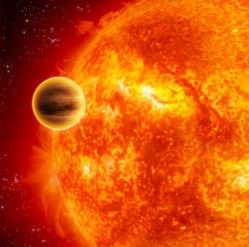
Though it is only half the mass of Jupiter it is bloated to nearly twice Jupiter’s size.
Astronomers have long wondered why some extra-solar planets are far bigger than expected, and WASP-17 points to the explanation. Scattered into a highly elliptical, retrograde orbit, it would have been subjected to intense tides. Tidal compression and stretching would have heated the gas-giant planet to its current, hugely bloated extent. “This planet is only as dense as expanded polystyrene, seventy times less dense than the planet we’re standing on”, said Coel Hellier, also of Keele University.
WASP-17 is the 17th new exoplanet found by the Wide Area Search for Planets (WASP) consortium of UK universities. The WASP team detected the planet using an array of cameras that monitor hundreds of thousands of stars, searching for small dips in their light when a planet transits in front of them. Geneva Observatory then measured the mass of WASP-17, showing that it was the right mass to be a planet. The WASP-South camera array that led to the discovery of WASP-17 is hosted by the South African Astronomical Observatory.
Source: STFC
Hubble Ultra Deep Field in 3-D
Here’s a new way to appreciate the Hubble Ultra Deep Field image, by flying through the 10,000 galaxies in this deepest of all Hubble images. Watch the whole video if you need the background on the Hubble Deep Field and subsequent Ultra Deep Field. Start at about 3:00 if you just want to see the distances between the galaxies in this image. Nice.
Via Gizmodo
Watching Science in Action on Mars
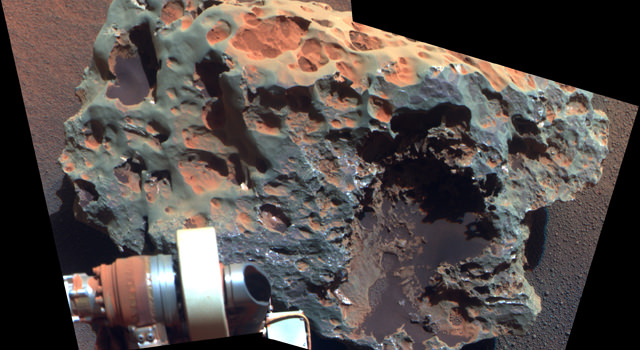
[/caption]
One of the great things about the Mars Exploration Rovers is that we get to see these scrappy little vehicles ramble across the surface of Mars, and watch science in action. Case in point: the meteorite found by Opportunity, dubbed “Block Island.” Scientists are debating all sorts of things about this watermelon-sized rock. How old is it? What is it made of? Where could it have come from? But not only are we learning about this alien rock, we’re also learning about the Red Planet itself and its environmental history.
See below for a new 3-D version of Block Island created by Stu Atkinson.
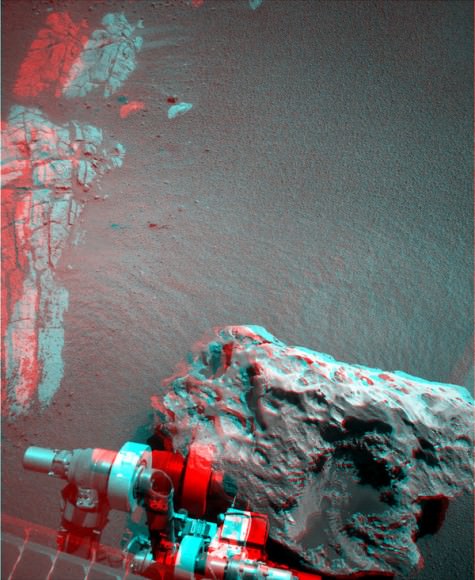
Scientists calculate Block Island is too massive to have hit the ground without disintegrating unless Mars had a much thicker atmosphere than it has now when the rock fell. An atmosphere slows the descent of meteorites, and with today’s thin Martian atmosphere, this heavy rock would have plummeted to the surface.
Block Island is approximately 60 centimeters (2 feet) in length, half that in height, probably weighs about a half ton, and has a bluish tint that distinguishes it from other rocks in the area.
Opportunity found a smaller iron-nickel meteorite, called “Heat Shield Rock,” in late 2004. Block Island is roughly 10 times as massive as Heat Shield Rock and several times too big to have landed intact without more braking than today’s Martian atmosphere could provide.
“Consideration of existing model results indicates a meteorite this size requires a thicker atmosphere,” said rover team member Matt Golombek of NASA’s Jet Propulsion Laboratory in Pasadena, Calif. “Either Mars has hidden reserves of carbon-dioxide ice that can supply large amounts of carbon-dioxide gas into the atmosphere during warm periods of more recent climate cycles, or Block Island fell billions of years ago.”
Additional studies also may provide clues about how weathering has affected the rock since it fell.
“There’s no question that it is an iron-nickel meteorite,” said Ralf Gellert of the University of Guelph in Ontario, Canada. Gellert is the lead scientist for the rover’s alpha particle X-ray spectrometer, an instrument on the arm used for identifying key elements in an object. “We already investigated several spots that showed elemental variations on the surface. This might tell us if and how the metal was altered since it landed on Mars.”
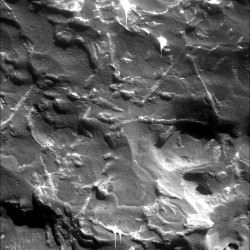
The microscopic imager on the arm revealed a distinctive triangular pattern in Block Island’s surface texture, matching a pattern common in iron-nickel meteorites found on Earth.
“Normally this pattern is exposed when the meteorite is cut, polished and etched with acid,” said Tim McCoy, a rover team member from the Smithsonian Institution in Washington. “Sometimes it shows up on the surface of meteorites that have been eroded by windblown sand in deserts, and that appears to be what we see with Block Island.”
Spectrometer observations have already identified variations in the composition of Block Island at different points on the rock’s surface. The differences could result from interaction of the rock with the Martian environment, where the metal becomes more rusted from weathering with longer exposures to water vapor or liquid.
“We have lots of iron-nickel meteorites on Earth. We’re using this meteorite as a way to study Mars,” said Albert Yen, a rover team member at JPL. “Before we drive away from Block Island, we intend to examine more targets on this rock where the images show variations in color and texture. We’re looking to see how extensively the rock surface has been altered, which helps us understand the history of the Martian climate since it fell.”
When the investigation of Block Island concludes, the team plans to resume driving Opportunity on a route from Victoria Crater, which the rover explored for two years, toward the much larger Endeavour Crater. Opportunity has covered about one-fifth of the 19-kilometer (12-mile) route plotted for safe travel to Endeavour since the rover left Victoria nearly a year ago.
Source: JPL
More Equinox Oddities in Saturn’s Rings
[/caption]
Today, August 11, 2009, is Saturn’s equinox. As we’ve been saying for a few months, the rings are going to disappear — at least from our vantage point on Earth. “Whenever equinox occurs on Saturn, sunlight will hit Saturn’s thin rings, the ring plane, edge-on,” said Linda Spilker, deputy project scientist for the Cassini spacecraft at Saturn. “The light reflecting off this extremely narrow band is so small that for all intents and purposes the rings simply vanish.” But even from the view at Saturn, weird things are happening in the rings, and the Cassini spacecraft has a front row seat watching it all take place. Above is one of the latest raw images sent back from Cassini, taken on August 7, 2009 showing how the sunlight is hitting the edge of the rings. It is a gorgeous shot. Below, see some of the strange sights Cassini has been seeing, including a buzzsaw, a blasted ring, and tell-tale moon shadows. For more about Saturn’s equinox, check out today’s 365 Days of Astronomy podcast with Emily Lakdawalla of the Planetary Society and she’ll tell you all about the weird and beautiful play of light and shadow going on at Saturn.
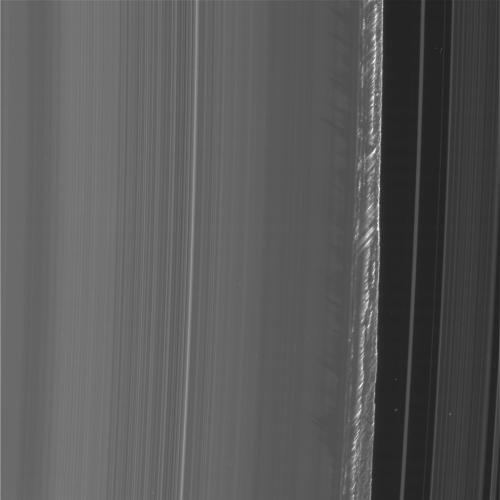
This image is really strange. Objects and waves in Saturn’s rings cast weird shadows back on the rings, and to me, this one looks like the jagged teeth of a saw. Interestingly, these shadows are faint, unlike the dark, black shadows we’ve seen in previous images. Check out our previous post about shadows on the rings.
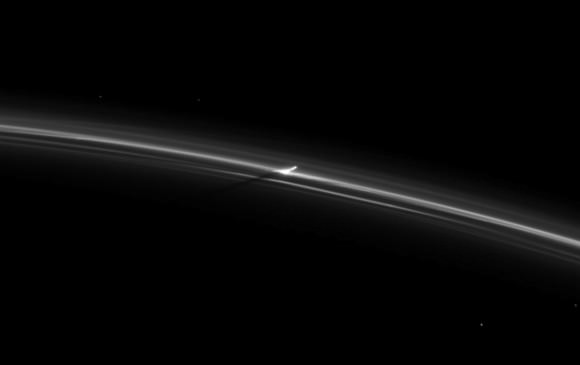
In this image, it appears as though a small object on an inclined orbit has punched through Saturn’s narrow F ring, bursting out from underneath, and dragging behind it a wake of particles from the rings. Phil Plait discussed this image at length over at Bad Astronomy, so check out his take on this crazy picture.
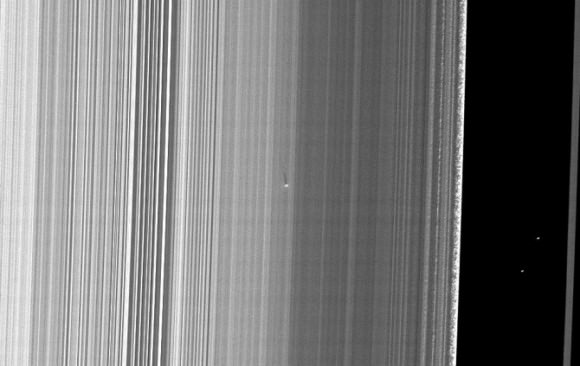
The angle of the sun hitting the rings makes objects show up that we normally don’t see. Take, for example, this newly discovered moonlet in Saturn’s B-ring. The small moon has a diameter of approximately 400 meters, and it only becomes obvious when sunlight hits the rings edge-on, creating a 40 km (25 mile) -long shadow. If the Sun was above or below the rings, no shadow would be cast, and therefore no moonlet would be visible.
Enjoy the sights, because Saturn’s equinox only happens once ever 15 Earth years.
For more on the mission and the equinox, check out the Cassini website.
One other Cassini note, the spacecraft performed a flyby of Titan on August 9, the 61st time it has targeted Titan as a flyby object, passing at a distance of 970 kilometers (603 miles) above the surface at a speed of 6.0 kilometers per second (about 13,400 mph). Unfortunately, all the data it gathered during this flyby were lost due to a temporary outage at the Goldstone Deep Space Network Facility during Cassini’s transmission back to Earth. As unique, high-priority data from Saturn’s equinox was planned to be taken soon after flyby, there was no redundant playback scheduled.
Rats!
Sources: 365 Days of Astronomy, Bad Astronomy, Astroengine, Cassini website
Hat tip to Stu Atkinson on the buzzsaw image!
New Device Extracts Oxygen from Moon Rocks
Are we perhaps one step closer to being able to live on the Moon? A new device developed by scientists in Cambridge, UK, can extract oxygen from Moon rock. This technology would be extremely important for creating a lunar bases for long term habitation, or using the Moon as a jump-off point to explore the deeper reaches of space.
The new device, a reactor developed by Derek Fray and his colleagues, was created from a modified electrochemical process the team invented in 2000 to get metals and alloys from metal oxides. The process uses the oxides — also found in Moon rocks — as a cathode, together with an anode made of carbon. To get the current flowing through the system, the electrodes sit in an electrolyte solution of molten calcium chloride (CaCl2), a common salt with a melting point of almost 800 °C.
The current strips the metal oxide pellets of oxygen atoms, which are ionized and dissolve in the molten salt. The negatively charged oxygen ions move through the molten salt to the anode where they give up their extra electrons and react with the carbon to produce carbon dioxide — a process that erodes the anode. Meanwhile, pure metal is formed over at the cathode.
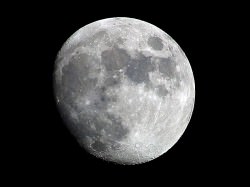
To make the system produce oxygen and not carbon dioxide, Fray had to make an unreactive anode. “Without those anodes, it doesn’t work,” said Fray. He discovered that calcium titanate, which is a poor electrical conductor on its own, became a much better conductor when he added some calcium ruthenate to it. This mixture produced an anode that barely erodes at all — after running the reactor for 150 hours, Fray calculated that the anode would wear away by roughly three centimeters a year.
To heat the reactor on the Moon would need just a small amount of power, Fray said, and the reactor itself can be thermally insulated to lock heat in. The three reactors would need about 4.5 kilowatts of power, which could be supplied by solar panels or even a small nuclear reactor placed on the Moon.
In their tests, Fray and his team used a simulated lunar rock called JSC-1, developed by NASA. Fray anticipates that three reactors, each a meter high, would be enough to generate a ton of oxygen per year on the Moon. Three tons of rock are needed to produce a ton of oxygen, and in tests the team saw almost 100% recovery of oxygen, he says. Fray presented the results last week at the Congress of the International Union of Pure and Applied Chemistry in Glasgow, UK.
Source: Nature
Perseid Radio Astronomy from the Fourth Plinth With Chris Lintott
[/caption]
Within hours, the peak of the annual Perseid meteor shower will begin. If you’re worried you’ll be clouded out, then let’s take a look at a different way that you can observe the activity… without your eyes!
Did you know that you can “listen” to meteor showers? If you’re a ham radio operator, then you prize the ionized trails that meteors leave in our atmosphere to allow further signals to “bounce” to more distant receivers. However, you don’t really need complicated equipment to listen to a meteor shower – just an FM receiver and an external antenna. Even your car radio will work!
Place your radio setting on the lowest frequency that doesn’t receive a clear signal and simply listen to the static. When a meteor passes overhead you’ll hear snatches of radio signals from distant stations, pops, buzzes, pings, shrieks, howls, and simple changes in the white noise. Sometimes it’s subtle – and sometimes it’s striking. One thing is for sure, the noises you hear are definitely out of this world! Your equipment can run the gambit from connecting a genuine outdoor FM antenna to an indoor receiver and recording with a tape deck for later playback, to a portable radio. I’ve even used an old television set connected to an outdoor television antenna tuned to channel 3. It’s all fun – and the results are amazing. Here are the dates for the 2009 Perseids.
 To open the public’s eyes to just how easy radio meteor listening can be, astrophysicist Chris Lintott will be doing a presentation live in Trafalgar Square on August 14th, 19-20h BST. Chris is a co-presenter of the BBC’s “The Sky at Night” astronomy programme, and is a lecturer at University College London and the project he’s about to take part in is very unique… The Fourth Plinth.
To open the public’s eyes to just how easy radio meteor listening can be, astrophysicist Chris Lintott will be doing a presentation live in Trafalgar Square on August 14th, 19-20h BST. Chris is a co-presenter of the BBC’s “The Sky at Night” astronomy programme, and is a lecturer at University College London and the project he’s about to take part in is very unique… The Fourth Plinth.
This summer, sculptor Antony Gormley has invited the world to help create an astonishing living monument. He is asking the people of the UK to occupy the empty Fourth Plinth in Trafalgar Square in London, a space normally reserved for statues of Kings and Generals. They will become an image of themselves, and a representation of the whole of humanity. Every hour, 24 hours a day, for 100 days without a break, a different person will make the Plinth their own.
Because of the appalling levels of light pollution in London, Lintott remembered a radio-meteor demonstration given by Andy Smith of G7IZU Radio Reflection Detection and his friend David Entwistle for “The Sky at Night” a couple of years ago, and wanted to do something along those lines. Since no power or wiring are allowed on the Plinth, Chris will be utilizing a recording done by Andy beginning tonight… a talent he’s quite good at! For every hour from midnight on, G7IZU Radio Reflection Detection will be recording the Perseid event and sending Chris the most active hours as MP3 files. He’ll then play these
to the masses over an amplified speaker while holding up photos of how it all works.
If you’re interested in the live radio-meteor/astronomy demonstration, you can access a live video of the Fourth Plinth – and be sure to join them on August 14th, 19-20h BST for Chris Lintott’s presentation!
Fate of the Universe

[/caption]What is the ultimate fate of our universe? A Big Crunch? A Big Freeze? A Big Rip? or a Big Bounce? Measurements made by WMAP or the Wilkinson Microwave Anisotropy Probe favor a Big Freeze. But until a deeper understanding of dark energy is established, the other three still cannot be totally ignored.
Ever since scientists proved the Big Bang to be the most plausible cosmological theory, and since it only focused more on how it might have all began, their attention started to shift to how the Universe would end. Thus, all 4 theories mentioned above (Big Crunch, Big Freeze, etc.) are actually offshoots of the Big Bang.
The Big Crunch predicts that, after having expanded to its maximum size, the Universe will finally collapse into itself to form the greatest black hole ever.
On the opposite side of the coin, the Big Freeze foretells of a universe that will continue to stretch forever, distributing heat evenly in the process until none is left to be usable enough. Hence, it is also known as the Heat Death.
A more dramatic version of the Big Freeze is the Big Rip. In this scenario, the Universe’s rate of expansion will increase substantially so that everything in it, down to the smallest atom, will be ripped apart.
In a cyclic or oscillatory model of the Universe, there will be no end … for matter and energy, that is. But for us and the Universe that we know of, there will definitely be a conclusion. In an oscillatory model, the Big Bang and Big Crunch form a pair known as the Big Bounce. Essentially, such a universe would simply expand and contract (or bounce) forever.
For astronomers to determine what the ultimate fate of the Universe should be, they would need to know certain information. Its density is supposedly one of the most telling.
You see, if its density is found to be less than the critical density, then only a Big Freeze or a Big Rip would be possible. On the other hand, if it is greater than the said critical value, then a Big Crunch or Big Bounce would most likely ensue.
The most accurate measurements on the cosmic microwave background radiation (CMBR), which is also the most persuasive evidence of the Big Bang, shows a universe having a density virtually equal to the critical density. The measurements also exhibit the characteristics of a flat universe. Right now, it looks like all gathered data indicate that a Big Crunch or a Big Bounce is highly unlikely to occur.
To render finality to these findings however, scientists will need to know the exact behavior of dark energy. Is its strength increasing? Is it diminishing? Is it constant? Only by answering these will they know the ultimate fate of the Universe.
We’ve got a few articles that touch on the fate the universe here in Universe Today. Here are two of them:
NASA also has some more:
Tired eyes? Let your ears help you learn for a change. Here are some episodes from Astronomy Cast that just might suit your taste:
- The End of the Universe Part 1: The End of the Solar System
- The End of the Universe Part 2: The End of Everything
Sources: NASA, Hubblesite
Spitzer Finds Evidence of Violent Planetary Collision
One of the main theories of how our Moon formed involves a violent cosmic collision between two planets. Astronomers have only been able to hypothesize what this collision was like, but now they have a better idea of what would ensue after such an event. With its infrared eyes the Spitzer Space Telescope has found the aftermath a collision between two planets, and what it shows is brutal. “This collision had to be huge and incredibly high-speed for rock to have been vaporized and melted,” said Carey M. Lisse of the Johns Hopkins University Applied Physics Laboratory, “This is a really rare and short-lived event, critical in the formation of Earth-like planets and moons. We’re lucky to have witnessed one not long after it happened.”
Watch the animation/recreation of the event in the video above.
LIsse and his team say that two rocky bodies, one as least as big as our moon and the other at least as big as Mercury, slammed into each other within the last few thousand years or so — not long ago by cosmic standards. The impact destroyed the smaller body, vaporizing huge amounts of rock and flinging massive plumes of hot lava into space.
Spitzer’s infrared detectors were able to pick up the signatures of the vaporized rock and amorphous silica — essentially melted glass — along with pieces of refrozen lava, called tektites.
[/caption]
Spitzer observed a star called HD 172555, which is about 12 million years old and located about 100 light-years away in the far southern constellation Pavo, or the Peacock (for comparison, our solar system is 4.5 billion years old).
The astronomers used an instrument on Spitzer, called a spectrograph, to break apart the star’s light and look for fingerprints of chemicals, in what is called a spectrum. What they found was very strange. “I had never seen anything like this before,” said Lisse. “The spectrum was very unusual.”
What they were seeing was the amorphous silica. Silica can be found on Earth in obsidian rocks and tektites. Obsidian is black, shiny volcanic glass. Tektites are hardened chunks of lava that are thought to form when meteorites hit Earth.
Large quantities of orbiting silicon monoxide gas were also detected, created when much of the rock was vaporized. In addition, the astronomers found rocky rubble that was probably flung out from the planetary wreck.
The mass of the dust and gas observed suggests the combined mass of the two charging bodies was more than twice that of our moon.
Their speed must have been tremendous as well — the two bodies would have to have been traveling at a velocity relative to each other of at least 10 kilometers per second (about 22,400 miles per hour) before the collision.
“The collision that formed our moon would have been tremendous, enough to melt the surface of Earth,” said co-author Geoff Bryden of NASA’s Jet Propulsion Laboratory, Pasadena, Calif. “Debris from the collision most likely settled into a disk around Earth that eventually coalesced to make the moon. This is about the same scale of impact we’re seeing with Spitzer — we don’t know if a moon will form or not, but we know a large rocky body’s surface was red hot, warped and melted.”
We know that collisions such as this must happen frequently. Giant impacts are thought to have stripped Mercury of its outer crust, tipped Uranus on its side and spun Venus backward, to name a few examples. Such violence is a routine aspect of planet building. Rocky planets form and grow in size by colliding and sticking together, merging their cores and shedding some of their surfaces. Though things have settled down in our solar system today, impacts still occur, as was observed last month after a small space object crashed into Jupiter.
“Almost all large impacts are like stately, slow-moving Titanic-versus-the-iceberg collisions, whereas this one must have been a huge fiery blast, over in the blink of an eye and full of fury,” said Lisse.
The team’s paper will appear in the Aug. 20 issue of the Astrophysical Journal.
Source: NASA

